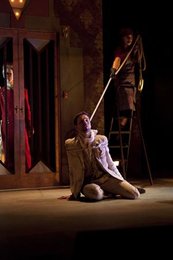Several of the first operas written around 1600 in Italy are dedicated to the myth of Orpheus. Developed by a group of Florentine aristocrats who wanted to revive ancient Greek tragedy as they understood it, opera was created as new type of drama in which music was not just occasionally inserted – like, for example, in the Shakespearean plays – but was instead permanently present with the characters singing all the time. That this was clearly not a reflection of real life as audiences then – or indeed today – experience may in part explain why the most famous singer of Greek mythology was so often chosen as the main protagonist of these early operas: who would be more convincing in the role of someone singing all the time but the man whose voice moved gods and mortals to tears and earned him a chance to rescue his beloved wife Euridice from the realm of the dead?
.jpg.aspx%3Fwidth=260&height=173) Monteverdi’s Orfeo, which premiered in 1607 in Mantua, is the earliest opera still in the repertoire. Its musical language is very different from that of later music dramas. There is no clear distinction between narrative sections (later to become recitatives) and introspective ones (arias), and a singer not specialised in this style has to adapt to it, for example by suppressing vibrato as much as possible – something all but one singer coped well with here, in Opera Theatre Company's new production; it was also interesting to compare how the singers interpreted the early Baroque ornaments in slightly different – if always tasteful and convincing – ways.
Monteverdi’s Orfeo, which premiered in 1607 in Mantua, is the earliest opera still in the repertoire. Its musical language is very different from that of later music dramas. There is no clear distinction between narrative sections (later to become recitatives) and introspective ones (arias), and a singer not specialised in this style has to adapt to it, for example by suppressing vibrato as much as possible – something all but one singer coped well with here, in Opera Theatre Company's new production; it was also interesting to compare how the singers interpreted the early Baroque ornaments in slightly different – if always tasteful and convincing – ways.
One of the strongest scenes of Ben Barnes’ production for OTC is the third act in which Orfeo encounters Charon, the ferryman who guides the dead across the river Styx to Hades. Here he appears as a customs officer inspecting the passports of black-clad, shadowy figures who – in a highly symbolic move – can only progress to Pluto’s realm once they leave all their baggage behind. As Orfeo is still alive his passport is not valid, and his more and more frantic attempts to convince Charon otherwise remain fruitless until the ferryman (appearing bored rather than moved by the singing) eventually falls asleep. This offers Orfeo a chance to sneak through unobserved, taking his lute as his only piece of luggage with him. He then emerges in the lobby of an art nouveau hotel in which Pluto resides with his wife Proserpina. When she convinces her husband to return Euridice to the grieving Orfeo, the blindfolded singer enters a lift with his wife. Two thirds up the way, however, he cannot resist looking at her to ensure that she is really with him, thus violating Pluto’s condition and losing her a for second time.
 Barnes, working with movement director Libby Seward, has beautifully choreographed many scenes; in particular the choruses often appear almost like a ballet, with the soloists either dancing or acting in gracefully orchestrated and coordinated movements. The setting (design by Joe Vañek) remains by and large unchanged, with the exception of a central wall element being cleverly turned around repeatedly, displaying either the customs officer's booth, the lift or a wall with a painting.
Barnes, working with movement director Libby Seward, has beautifully choreographed many scenes; in particular the choruses often appear almost like a ballet, with the soloists either dancing or acting in gracefully orchestrated and coordinated movements. The setting (design by Joe Vañek) remains by and large unchanged, with the exception of a central wall element being cleverly turned around repeatedly, displaying either the customs officer's booth, the lift or a wall with a painting.
There is some fine singing on display particularly by Oliver Mercer as Orfeo, but also by Sadhbh Dennedy (who is impressive in her opening scene as Musica), Karolina Blixt and DaireHalpin. Matthew Treviño’s dark bass gives both Charon and Pluto a suitably powerful and emotionally detached edge as they certainly won’t give in to emotional blackmail – or so they think. Some of the most moving moments, however, are the silent ones, for example when the music almost dies as Blixt’s messenger has to reveal Euridice’s passing. The ensemble conveys the energy and emotional engagement of Monteverdi’s many choruses equally well, ably assisted by the orchestra on its historical instruments.
Orfeo is in some ways better suited to OTC’s practice of reducing the orchestra to a small ensemble than many later works, as its orchestral requirements are much smaller than those of a Donizetti or even Mozart opera; the seven players under the direction of Andrew Synnott may represent something like a quarter or a third of the number of players that would have been involved in Mantua in 1607. By switching from trumpet to cornet, from Baroque guitar to chitarrone, and from harpsichord to organ to regal, they gave the impression of an even larger and more varied ensemble.
Overall OTC’s Orfeo is another little triumph in the face of continuing adverse circumstances for opera in Ireland.
Wolfgang Marx